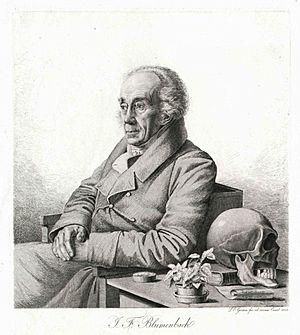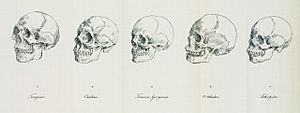Johann Friedrich Blumenbach facts for kids
Quick facts for kids
Johann Friedrich Blumenbach
|
|
|---|---|

Johann Friedrich Blumenbach
|
|
| Born | 11 May 1752 |
| Died | 22 January 1840 (aged 87) |
| Alma mater | University of Jena University of Göttingen |
| Known for | comparative anatomy; scientific racism |
| Scientific career | |
| Fields | Physiology |
| Institutions | Göttingen |
| Doctoral advisor | Christian Wilhelm Büttner |
| Other academic advisors | Ernst Gottfried Baldinger Christian Gottlob Heyne |
| Doctoral students | Johann Heinrich Friedrich Link Friedrich Stromeyer Karl Theodor Ernst von Siebold |
| Influenced | Alexander von Humboldt |
| Author abbrev. (zoology) | Blumenbach |

Johann Friedrich Blumenbach (born May 11, 1752 – died January 22, 1840) was a German doctor, naturalist, and anthropologist. He is often seen as a main founder of zoology (the study of animals) and anthropology (the study of humans). He helped make these subjects scientific.
Blumenbach was one of the first to study humans as part of natural history. He used comparative anatomy (comparing body structures) to classify human groups. He suggested there were five main groups: Caucasian, Mongolian, Malayan, Ethiopian, and American. He was also part of a group of thinkers called the Göttingen School of History.
Many scientists of his time thought Blumenbach was a great thinker. He also taught or influenced many future German biologists, like Alexander von Humboldt.
Contents
Early Life and Education
Blumenbach was born in Gotha, Germany. His father was a school headmaster. His mother came from a family of academics. He grew up in a family that valued learning.
He went to the Illustrious Gymnasium in Gotha. Then he studied medicine at the University of Jena and later at the University of Göttingen. By age sixteen in 1768, people saw him as very talented.
He earned his medical degree in 1775 from Göttingen. His thesis was called De generis humani varietate nativa. This means On the Natural Variety of Mankind. This work became very important for later ideas about human groups. It also started his research on skulls.
Career and Discoveries
In 1776, Blumenbach became a professor of medicine in Göttingen. He also became an inspector at the natural history museum. In 1778, he became a full professor. He wrote many articles on medicine, physiology, and anatomy.
He followed the ideas of Albrecht von Haller in physiology. He often compared how human bodies work to how animal bodies work. In 1799, Blumenbach gave the woolly mammoth its first scientific name, Elephas primigenius. This means "first-born elephant."
His book Institutiones Physiologicae (1787) was very popular. It was a clear summary of how animal bodies function. This book was used as a textbook for physiology in Germany for many years. It was also translated into English.
He was also well-known for his Handbuch der vergleichenden Anatomie (Handbook of comparative anatomy). This book was published from 1805 to 1824. It was also translated into English. This manual was valued for its accurate observations.
Blumenbach traveled to Switzerland in 1789 and England in 1788 and 1792. He became a member of many important scientific groups. These included the Royal Society of London and the American Academy of Arts and Sciences. He retired in 1835 and died in Göttingen in 1840.
Understanding Human Groups
Blumenbach studied human differences by looking at skull shapes and skin color. He described sixty human skulls in his work Decas craniorum (1790–1828). This work helped start the study of craniometry (measuring skulls).
In 1795, he created a system to name what he called "five main varieties of humankind, but one species." He believed all humans belonged to a single species.
Blumenbach's five varieties of humans were:
- The Caucasian or white group. He was the first to use this term for Europeans.
- The Mongolian or yellow group, including East Asians.
- The Malayan or brown group, including Southeast Asians and Pacific Islanders.
- The Ethiopian or black group, including sub-Saharan Africans.
- The American or red group, including Native Americans.
Blumenbach thought that differences in human appearance came from climate and lifestyle. He stressed that these differences were small and changed gradually. This made it hard to separate the groups clearly. He also noted that skin color alone was not enough to tell groups apart.
He did not say one group was better than another. However, he described the Caucasian form as the most "original" one. He believed other forms "changed" from it. In his time, "changed" meant adapting to a new environment. For example, he thought skin color changed due to the tropical sun. He also believed these changes could be reversed if the environment changed.
Blumenbach did not think his ideas were racist. He strongly criticized other scientists who claimed some groups were inferior. He wrote essays showing that non-white people could be excellent in arts and sciences. He was against slavery and the idea that some groups were naturally wild. However, parts of his ideas were later used by others to support scientific racism.
Other Animal Studies
Blumenbach was one of the first scientists to understand different kinds of primates. In 1775, he mentioned the name Simia troglodytes for the common chimpanzee. He later clarified that this was a new name for the chimpanzee. Before him, other scientists had confused chimpanzees with humans or orangutans.
Today, the scientific name for the common chimpanzee is Pan troglodytes. This name includes Blumenbach's contribution from 1776.
He also wrote a manual called Handbuch der Naturgeschichte (Handbook of Natural History). This book had many editions and was translated. Blumenbach was also one of the first to study the platypus. He gave it the scientific name Ornithorhynchus paradoxus.
The Bildungstrieb (Formative Drive)
Blumenbach made important contributions to ideas about how living things develop. He suggested a concept called vis formativus or Bildungstrieb. This means a "formative drive" or "shaping force." He believed this was an inborn force in every living thing. It helped organisms create, keep, and repair their shape.
Blumenbach thought that all living things, from humans to tiny molds, have this force. It helps them grow into their specific form. It also helps them stay healthy and repair themselves if they get hurt. He said this force was not just physical or chemical.
He compared this unknown force to gravity. We know gravity exists and what it does, even if we don't fully understand its cause. In the same way, the formative drive explains how animals are created. This idea became important in German biology and philosophy.
Influence on German Science
Blumenbach was seen as a leading scientist in Germany. Many important thinkers, like Immanuel Kant and Friedrich Schelling, praised his biological ideas.
Many German biologists in the early 1800s studied with him or were inspired by him. These included famous scientists like Alexander von Humboldt.
See also
 In Spanish: Johann Friedrich Blumenbach para niños
In Spanish: Johann Friedrich Blumenbach para niños
- Craniometry
- Scientific racism


